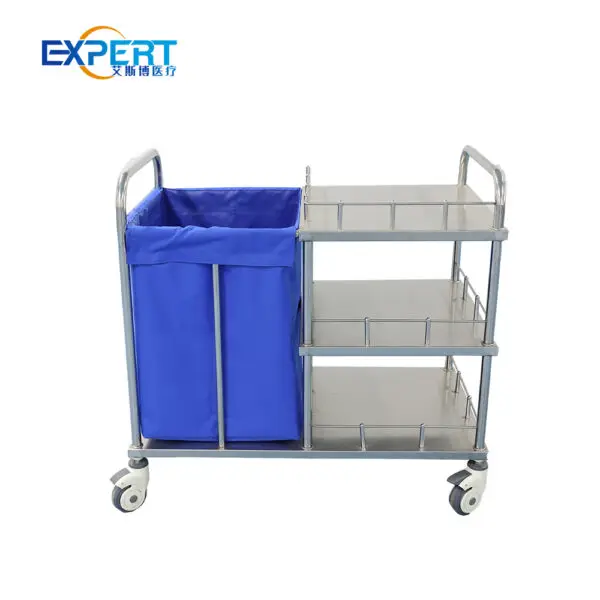عنوان
304 شارع الكاردينال الشمالي
مركز دورتشستر ، ماساتشوستس 02124
ساعات العمل
من الاثنين إلى الجمعة: 7 صباحًا - 7 مساءً
عطلة نهاية الأسبوع: 10 صباحًا - 5 مساءً
مرحباً بكم في مدونتي!
قبل أن نتعمق في المحتوى، أود منك الانضمام إليّ على منصات التواصل الاجتماعي الخاصة بي حيث أشارك المزيد من الأفكار وأتواصل مع المجتمع وأنشر التحديثات. إليك كيفية التواصل معي:
فيسبوك:https://www.facebook.com/profile.php?id=100071234835011
لينكدإن:https://www.linkedin.com/company/74943205/admin/dashboard/
يوتيوب:www.youtube.com/@shandongexpertmedicalequip4695
تيك توك:www.tiktok.com/@expertmedical
الآن، لنبدأ رحلتنا معًا. أتمنى أن تجد المحتوى هنا مفيدًا وجذابًا وقيمًا.


في بيئة الرعاية الصحية سريعة التطور، تُعد الكفاءة والتنظيم أمرًا بالغ الأهمية. يعتمد المتخصصون الطبيون بشكل كبير على المعدات الأساسية لتقديم أفضل رعاية للمرضى، ومن بينها عربة رعاية المستشفى التي تلعب دورًا محوريًا. سواءً استُخدمت لتوزيع الأدوية، أو الاستجابة للطوارئ، أو الإجراءات الطبية الروتينية، فإن عربة عالية الجودة... عربة رعاية المستشفى يمكن أن يُحسّن سير العمل وسلامة المرضى بشكل كبير. ومع ذلك، لا تزال العديد من مرافق الرعاية الصحية تستخدم عربات قديمة، غافلةً عن المخاطر التي تُشكّلها. إذا كان طاقمك الطبي يُعاني من عدم الكفاءة، أو مخاوف تتعلق بالسلامة، أو أعطال متكررة، فقد يكون الوقت قد حان للتفكير في تحديثها. تستكشف هذه المقالة خمس علامات تحذيرية تُشير إلى ضرورة استبدال عربة رعاية المستشفى، وتُقدّم إرشادات لاختيار بديل أفضل.
واحدة من العلامات الأكثر وضوحا على أن عربة رعاية المستشفى لم تعد العربة تلبي احتياجاتك، بل تحتاج إلى صيانة متكررة. فالعربة التي تتعطل باستمرار تُعيق سير العمل وتُؤخر رعاية المرضى الأساسية. تتراوح الأعطال بين عطل في العجلات وكسر في الأقفال، وأعطال إلكترونية في الطرازات الأكثر تطورًا، مما يجعل العمليات اليومية أكثر إحباطًا وأقل كفاءة.
إذا كان لديك عربة رعاية المستشفى إذا كانت عربة المرضى تتطلب إصلاحات شهرية تقريبًا، فقد يكون الوقت مناسبًا للتفكير في ترقية. الاستثمار في عربة متينة وعالية الأداء لن يعزز الكفاءة فحسب، بل سيُحسّن أيضًا سير عمل الموظفين وسلامة المرضى.

تتطلب بيئات المستشفيات عرباتٍ سهلة الحركة على مختلف أسطح الأرضيات. إذا كانت عربتك صعبة الدفع، أو ذات عجلات صلبة، أو لا تتحرك بسلاسة، فقد تُصبح عبئًا بدلًا من أن تكون أداةً مفيدة.
حديث عربة رعاية المستشفى بفضل عجلاتها عالية الجودة، وعجلاتها السلسة الحركة، ومقابضها المريحة، يُمكن تحسين التنقل بشكل ملحوظ. يضمن التحديث إلى طراز مُصمم جيدًا سهولة التنقل في الممرات والمصاعد وغرف المرضى، مما يُمكّن الطاقم الطبي من أداء واجباته بكفاءة دون أي عوائق.
كفاءة عربة رعاية المستشفى يجب أن توفر مساحة تخزين واسعة للمستلزمات الطبية الأساسية، مع ضمان سهولة الوصول إليها. إذا كانت عربة التسوق الحالية لديك غير كافية من حيث المساحة، أو أدراجها مزدحمة، أو تفتقر إلى مساحة تخزين آمنة للأدوية، فقد يكون الوقت قد حان لتحديثها.
| ميزة | عربة قديمة | عربة حديثة |
|---|---|---|
| سعة التخزين | حجرات محدودة وأدراج مزدحمة | أقسام واسعة ومنظمة بشكل جيد |
| آلية القفل | الأقفال الأساسية أو القديمة | أمان متقدم مع الدخول الرقمي أو بدون مفتاح |
| التخصيص | تخطيط ثابت، من الصعب تعديله | تصميم معياري للتكوينات القابلة للتخصيص |
| إمكانية الوصول | إمدادات يصعب الوصول إليها، وتصميم غير فعال | تصميم مريح وسهل الوصول للاسترجاع السريع |
توفر الموديلات الأحدث حلول تخزين محسنة، بما في ذلك الأدراج المعيارية، وأنظمة القفل الآمنة، والحجرات التي يمكن الوصول إليها بسهولة والتي تعمل على تحسين التنظيم وسير العمل.

الأمن هو جانب حاسم في أي عربة رعاية المستشفى، خاصةً عند التعامل مع الأدوية والأدوات الطبية الحساسة. إذا كانت عربة التسوق الخاصة بك تفتقر إلى إجراءات أمنية متقدمة، مثل الأقفال الإلكترونية أو أنظمة التحكم في الدخول، فقد تُعرّض المرضى والموظفين للخطر.
الترقية إلى عربة رعاية المستشفى بفضل ميزات الأمان الحديثة، مثل الوصول البيومتري أو تقنية تحديد الهوية بموجات الراديو، يمكننا ضمان الامتثال لمعايير الصناعة وحماية الموارد الطبية القيمة.
مع تقدم تكنولوجيا الرعاية الصحية، يجب على معدات المستشفيات مواكبة ذلك. إذا كنت عربة رعاية المستشفى إذا كان نظام الرعاية الصحية يفتقر إلى ميزات مثل مصادر الطاقة المتكاملة، أو الشاشات الرقمية، أو التوافق مع أنظمة السجلات الطبية الإلكترونية (EMR)، فقد يؤدي ذلك إلى إبطاء الكفاءة.
حديث عربات رعاية المستشفيات تم تصميمها لتتكامل بسلاسة مع التكنولوجيا الطبية، مما يسمح لمقدمي الرعاية الصحية بالعمل بذكاء، وليس بجهد أكبر.
أ عربة رعاية المستشفى تُعد عربة نقل المرضى أداةً أساسيةً في أي منشأة طبية، إلا أن استخدام نموذج قديم قد يؤدي إلى انخفاض الكفاءة، ومخاطر السلامة، وزيادة التكاليف. إذا كانت عربة نقل المرضى لديك تتعطل بشكل متكرر، أو تفتقر إلى التخزين المناسب، أو يصعب تحريكها، أو تعاني من ضعف الأمان، أو لا تتكامل جيدًا مع التقنيات الحديثة، فقد حان الوقت للترقية. الاستثمار في عربة رعاية صحية عالية الجودة ومتطورة تقنيًا في المستشفيات يُحسّن سير العمل، ويعزز سلامة المرضى، ويُحسّن عمليات الرعاية الصحية بشكل عام. من خلال التعرّف على هذه العلامات التحذيرية مبكرًا، يمكنك اتخاذ قرارات مدروسة لتحسين كفاءة وفعالية منشأتك الطبية.
عادةً ما تدوم عربات رعاية المستشفيات من ٥ إلى ١٠ سنوات، ولكن الأعطال المتكررة، أو تقادم الميزات، أو تغيرات متطلبات المستشفى قد تستدعي استبدالها مبكرًا. تساعد التقييمات الدورية في تحديد وقت الحاجة إلى التحديث.
وتشمل الميزات الرئيسية التي يجب مراعاتها سهولة التنقل، ومساحة التخزين الواسعة، وأنظمة القفل الآمنة، والتصميم المريح، والتكامل التكنولوجي مثل تتبع الأدوية الرقمية وأنظمة الأمان الإلكترونية.
نعم، تعمل العربات الإلكترونية المزودة بمصادر طاقة مدمجة وتتبع رقمي وآليات قفل ذكية على تعزيز الكفاءة وتحسين الأمان وتقليل أخطاء الأدوية، مما يجعلها استثمارًا قيمًا لمرافق الرعاية الصحية.
توفر العديد من عربات الرعاية في المستشفيات الحديثة تصميمات معيارية تسمح بالتخصيص لتطبيقات طبية مختلفة، مما يتيح للمرافق تصميم العربات بناءً على احتياجات الأقسام وكفاءة سير العمل ومتطلبات التخزين.
لزيادة عمر عربة الرعاية في المستشفى، قم بتنظيف أسطح العربة بانتظام، وفحص العجلات والأقفال بحثًا عن التآكل والتلف، وتحديث ميزات الأمان حسب الحاجة، وضمان التنظيم والتخزين المناسبين للإمدادات الطبية.
إشعارات
